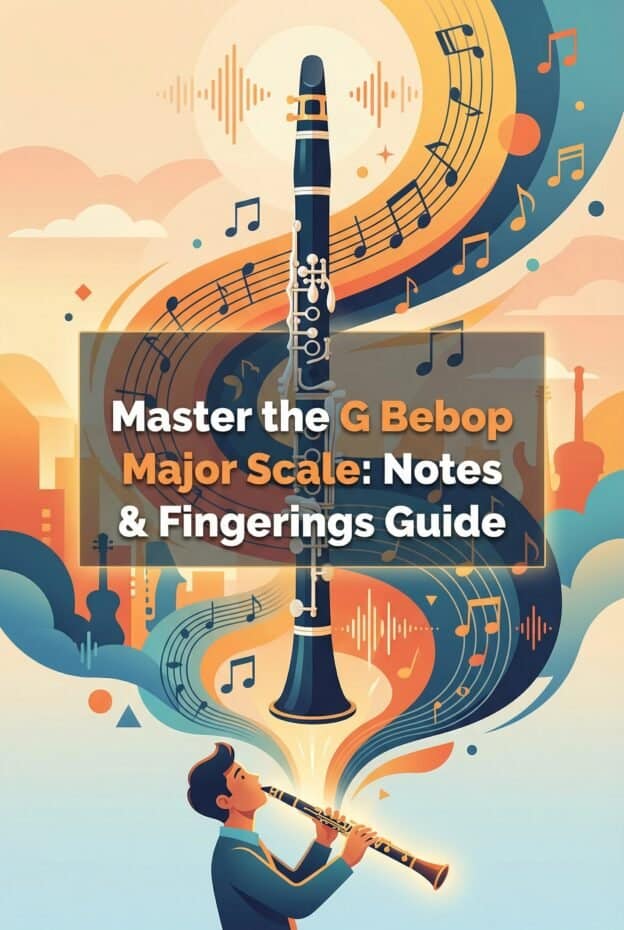G Bebop Major Scale notes: G A B C D D# E F# (8-note bebop major scale). On clarinet, you use standard G major fingerings with a chromatic D# passing tone between D and E. Practice in both directions with a metronome, then apply to II-V-I lines in the key of G for fluent jazz improvisation.
Quick Reference: G Bebop Major Scale Notes and Fingering (Printable Chart)
The G Bebop Major Scale is an 8-note major scale used in jazz improvisation. Its notes are: G, A, B, C, D, D#, E, F#. Compared with a regular G major scale, it adds a chromatic passing tone, D#, between the 5th (D) and 6th (E) degrees to keep chord tones on downbeats in fast lines.
On B-flat clarinet, written G Bebop Major sounds as F Bebop Major in concert pitch. You still read and finger it as written G major with the added D#. This makes it practical for big band charts, combo lead sheets, and improvisation over standards notated for clarinet or B-flat instruments.
Written notes for B-flat clarinet (ascending): G – A – B – C – D – D# – E – F# – G.
Written notes for B-flat clarinet (descending): G – F# – E – D# – D – C – B – A – G.
Core fingering outline (chalumeau to clarion): low G with all left-hand fingers plus right-hand 1-3, A by lifting right-hand 2-3, B with left-hand 1, C with left-hand 1-2, D with left-hand 1-2-3 and register key, D# using side key or sliver key, E with left-hand 1-2 and register, F# with left-hand 1 and register.
For the printable chart, imagine a vertical layout: each scale degree has a staff note, name, and a clarinet fingering diagram. The D# row shows both the standard side D# key and an alternate right-hand fingering for smoother chromatic motion at higher tempos.
The downloadable fingering chart should be provided as a high-resolution PNG or PDF. Include separate diagrams for low-register D# and mid-register D#, since the choice of side key or alternate fingering affects both intonation and technical ease in bebop lines.
How the G Bebop Major Scale Differs from the Standard Major Scale
The G Bebop Major Scale differs from the standard G major scale by one note: the added D#. Regular G major has 7 notes (G, A, B, C, D, E, F#), while the bebop version has 8 (G, A, B, C, D, D#, E, F#). That extra chromatic passing tone is the key to its rhythmic function.
In jazz theory, this scale is often described as a major scale with a raised 5th degree. In G, the 5th is D; raising it a half step gives D#. When you play straight 8th notes using this 8-note scale over a G major or G6 chord, chord tones (G, B, D, E) naturally land on downbeats if you start on a chord tone.
On clarinet, this difference feels mainly in your right hand. The standard G major scale from low G to top G crosses the break smoothly. Adding D# forces a quick side key or alternate fingering, which can disrupt hand position if you are not prepared. That is why many players struggle with clean bebop articulation at speed.
Harmonically, the G Bebop Major Scale fits G major, G6, Gmaj7, and Gmaj9 chords. It also works over E minor 7 in some contexts, since the notes overlap heavily. The D# functions as a chromatic approach to E, often heard in lines by Charlie Parker and Dizzy Gillespie, even when clarinet was not the lead instrument.
Compared with the G Bebop Dominant Scale (G Mixolydian with a major 7 passing tone), the G Bebop Major Scale has a brighter, more diatonic color. It is especially useful over tonic major chords at the end of II-V-I progressions, where you want to sound grounded but still rhythmically active.
Step-by-Step Practice Routine for Clarinetists
A structured routine helps you turn the G Bebop Major Scale from a pattern into real improvisational vocabulary. The following steps assume an intermediate clarinetist who can already play G major comfortably across the break and read basic jazz rhythms.
Step 1: Slow note mapping and finger awareness
Start with written G to top G, quarter notes at quarter = 60. Say the note names out loud: G, A, B, C, D, D#, E, F#, G. Focus on the D to D# to E segment. Keep your right-hand fingers close to the keys and avoid lifting the hand when using the D# side key.
Repeat descending, still in quarter notes: G, F#, E, D#, D, C, B, A, G. Use a tuner to check D# and F#, since these often run sharp or flat depending on your embouchure and instrument setup. Aim for consistent tone color across the passing tone.
Step 2: Rhythmic patterns and articulation
Switch to 8th notes at quarter = 60. Play the scale up and down, slurred, then tongued. Next, practice in rhythmic cells: 4 ascending notes, then back 1, repeated. For example: G A B C, B C D D#, C D D# E, D D# E F#, etc. This mimics bebop line shapes.
Add articulation patterns: tongue 2, slur 2; tongue 3, slur 1; accent every downbeat. The goal is to hear how the chord tones land on accented beats when you use the full 8-note scale. This prepares you to place lines over a walking bass or ride cymbal pattern.
Step 3: Metronome ladder and tempo goals
Use a metronome ladder with clear numeric goals.
- Week 1: 8th notes at quarter = 80, 4 clean repetitions ascending and descending.
- Week 3: 8th notes at quarter = 120, 3 clean repetitions with mixed articulations.
- Week 6: 8th notes at quarter = 160, 2 clean repetitions in both slurred and tongued versions.
Increase tempo by 4 bpm once you can play the scale twice in a row without chipped notes or rhythmic rushing. If the D# feels unstable, stay at the current tempo and isolate the D-D#-E fragment in 16th notes.
Step 4: Interval and arpeggio integration
Practice diatonic thirds within the G Bebop Major Scale: G-B, A-C, B-D, C-D#, D-E, D#-F#, E-G, F#-A, then descend. This trains your fingers to handle the chromatic passing tone inside melodic intervals, not only in straight stepwise motion.
Next, outline chord tones inside the scale: play G-B-D-E ascending, then fill in scale tones between them. For example: G A B C B D C E D F# E G. This turns the scale into melodic fragments that resemble real bebop lines over G6 or Gmaj7 chords.
Step 5: Application to II-V-I progressions
Use the G Bebop Major Scale over a II-V-I in G major: Am7 – D7 – Gmaj7. On clarinet, practice a 4-bar phrase where you use A Dorian over Am7, D Mixolydian over D7, and G Bebop Major over Gmaj7. Aim to land on G, B, or E on the first beat of the Gmaj7 bar.
Record yourself and listen for how the D# resolves to E on a strong beat. This chromatic resolution is central to the bebop sound. Over time, mix in enclosure patterns, such as approaching B from above and below using C and A within the G Bebop Major framework.
Step 6: 32-bar standard integration
Choose a simple 32-bar standard in G major or with a final cadence to G, such as a rhythm changes bridge that resolves to G. Write or improvise at least one chorus where you consciously use G Bebop Major on every tonic G chord. Keep a practice log of how often you hit clean D#-E resolutions.
Within 4 to 6 weeks, you should be able to play at least one full chorus at quarter = 140 using the G Bebop Major Scale in multiple spots, without thinking mechanically about the pattern. That is a realistic outcome for an intermediate clarinetist practicing 15 focused minutes per day.
Instrument Anatomy: Why Clarinet Mechanics Matter for Bebop Fingering
The clarinet's register system and keywork strongly affect how you play the G Bebop Major Scale. The instrument has distinct registers: chalumeau (low E to F), throat tones (G to B-flat), clarion (B to high C), and altissimo (above high C). The register break around B-flat/B is a common trouble spot for fast bebop lines.
In the G Bebop Major Scale, the D-D#-E sequence usually sits in the clarion register. D is fingered with left-hand 1-2-3 plus the register key, E with left-hand 1-2 plus register, and D# uses a side key or alternate fingering. The side key placement on most clarinets requires a subtle roll of the right-hand index finger.
Because bebop lines often use continuous 8th notes, any extra motion in the right hand can cause bumps in the line. You want minimal finger lift, relaxed knuckles, and efficient contact with the D# key. The trill keys above the right-hand stack also come into play for some alternate D# fingerings, especially in the upper clarion.
Think of the clarinet's tone holes as a ladder. When you play D#, you are closing and opening holes in a pattern that does not align perfectly with the natural harmonic series. This is why D# can feel unstable in pitch and response. Understanding this helps you accept that some extra embouchure and voicing control is normal.
Annotated fingering diagrams for the G Bebop Major Scale should highlight the following:
- Standard clarion D fingering with register key.
- Side D# key operated by the right-hand index finger.
- Alternate D# fingering using a right-hand combination for smoother chromatic runs.
- Clarion E and F# with clear indication of which fingers stay close to the keys.
In SVG or PNG diagrams, use contrasting colors to show which fingers move between D and D#. This visual cue helps students see that only a small motion is needed, reducing tension and improving speed in bebop passages.
Common Technical Challenges and Troubleshooting Tips
Many clarinetists face similar problems when learning the G Bebop Major Scale: cracking across the break, muddy D#, uneven rhythm, and awkward side key coordination. Each issue has a mechanical and musical solution that you can address step by step.
Problem 1: Cracking tone across the register break
When moving from C to D or from B to C to D within the scale, the sound may crack or squeak. This usually comes from late register key timing, collapsing embouchure, or too little air support. The added D# can magnify the problem because you focus on the side key instead of the air stream.
Fix this by practicing slow C-D-E-F# with a crescendo, slurred, focusing on steady air and firm corners. Add the D# later: C-D-D#-E-F#. Keep the register key pressed slightly before the fingers move. Use a mirror to check that your chin stays flat and does not bunch up during the register shift.
Problem 2: Muddy or out-of-tune D#
A muddy D# often results from partial closure of the side key, excessive finger pressure, or a leaking pad. Intonation issues can stem from biting, loose embouchure, or an instrument that favors sharp D# in the clarion register.
Test D# alone with a tuner. Play long tones, starting softly, crescendoing to forte, then decrescendoing. Aim for a stable pitch within +/-10 cents. If the sound is fuzzy, check that the side key pad seals fully and that your finger contacts the key cleanly. If leaks persist, consult a technician for pad replacement or regulation.
Problem 3: Unclear rhythmic placement of the passing tone
Sometimes the D# feels like a random extra note instead of a precise passing tone. This leads to lines that sound rushed or out of time, especially at faster tempos. The solution is to practice with clear rhythmic frameworks and accent patterns.
Set a metronome at quarter = 80. Accent every downbeat while playing continuous 8th notes in the G Bebop Major Scale. Make sure chord tones (G, B, D, E) land on the accented beats. Then, isolate 1-bar fragments where D# resolves to E on a strong beat, such as beat 1 or 3, and repeat them until they feel natural.
Problem 4: Stiff right hand and side key tension
Grip and tension in the right hand slow your D# motion and can even cause pain. This often happens when players lift the entire hand to reach the side key. The fix is to re-balance the instrument and retrain the finger motion.
Practice holding the clarinet so the thumb rest supports the weight comfortably. Then, without playing, tap the D# side key lightly with the right-hand index finger while keeping the other fingers hovering close to their holes. Repeat 50 slow taps daily, focusing on relaxed motion. Then integrate this feel into D-D#-E patterns.
Problem 5: Lines sound like scales, not music
Even with good technique, your improvisation may sound like you are just running the G Bebop Major Scale up and down. To fix this, focus on small melodic cells and phrasing, not full-range runs.
Choose 3-note and 4-note fragments that include D#, such as B-D-D#, D-D#-E, or E-D#-D-B. Practice them in different rhythmic placements, with swing feel, and insert them into simple blues or II-V-I progressions. Record yourself and check whether the fragments blend into the line instead of standing out as pure scale practice.
Maintenance and Setup Tips to Improve Bebop Playing
Good maintenance and setup make fast bebop lines on the G Bebop Major Scale more reliable. Sticky keys, warped reeds, or misaligned pads can sabotage clean D# fingerings and consistent articulation. A short, regular checklist helps keep your clarinet responsive.
Reed selection matters. Choose a reed strength that allows easy articulation at quarter = 160 without biting. Many intermediate players prefer strengths around 2.5 to 3 on common brands. Break in new reeds by playing them for 5 to 10 minutes per day over several days instead of using them at full length immediately.
Mouthpiece choice and facing affect response in the clarion register. A medium tip opening with a balanced facing curve often gives enough flexibility for expressive bebop phrasing without sacrificing control on D# and F#. If D# feels resistant, test a slightly softer reed or a mouthpiece with a more forgiving facing.
Inspect the bore and pads regularly. Use a swab after every session to remove moisture, especially after long bebop practice with lots of air flow. Check the side D# key pad for signs of wear or compression, since even a small leak can blur the passing tone in fast passages.
Key regulation affects trill and side key responsiveness. If the D# key feels sluggish or noisy, a technician can adjust spring tension and key height. Light lubrication on pivot screws, done by a professional or under guidance, can also improve the feel of side keys and trill keys used in alternate D# fingerings.
Finally, schedule a full checkup at least once a year if you practice bebop regularly. Fast, repetitive patterns like the G Bebop Major Scale reveal small mechanical issues quickly. Addressing them early keeps your technique focused on musical goals instead of fighting the instrument.
Historical Context: Bebop, Clarinet, and the 1940s Jazz Scene
Bebop emerged in the early 1940s in New York, centered around clubs like Minton's Playhouse and Monroe's Uptown House. Musicians such as Charlie Parker, Dizzy Gillespie, Thelonious Monk, and Kenny Clarke developed a new language of fast tempos, complex harmonies, and chromatic lines that relied on scales like the bebop major.
Clarinet had been a leading jazz voice in the swing era, with Benny Goodman and Artie Shaw dominating the late 1930s. As bebop took hold, the saxophone, especially alto and tenor, became more prominent. Still, clarinetists adapted the new vocabulary, incorporating chromatic passing tones and extended scales similar to the G Bebop Major Scale into their solos.
Benny Goodman experimented with modern harmonies and bebop-influenced lines in the mid-1940s. Recordings like “Air Mail Special” (Columbia, 1941) and later sessions in the late 1940s show a shift toward more angular, chromatic phrasing. While not always labeled as bebop, the underlying scale usage aligns with bebop concepts, including raised 5ths and chromatic approaches.
Artie Shaw's later recordings, such as those from 1949 and 1950, also show more complex harmonic thinking. Lines that outline tonic major chords with chromatic passing tones echo the function of the bebop major scale, even if the exact G Bebop Major pattern is not named in the arrangements.
According to secondary sources like Oxford Music Online and articles from the Smithsonian Jazz collection, clarinet's role in bebop was more niche but still significant. Players in smaller ensembles and regional scenes used clarinet to explore bebop language, often adapting saxophone lines and scale patterns, including bebop major and dominant scales, to the clarinet's unique register system.
In this historical context, the G Bebop Major Scale represents one codified version of the chromatic language that clarinetists heard from saxophonists and trumpeters. Learning it today connects you not only to theory but also to the evolving role of the clarinet from swing to modern jazz.
Notable Clarinet Recordings and Archival References
While the term “G Bebop Major Scale” is a later theoretical label, the sound of this scale appears in many mid-century recordings. Listening closely helps you internalize its phrasing and articulation on clarinet, beyond written exercises.
Benny Goodman's small group recordings from the 1940s, such as those collected on “Benny Goodman Sextet” releases, feature lines where Goodman uses chromatic passing tones between chord tones on major chords. On up-tempo tunes, you can hear passing tones between D and E over G harmony that function like the D# in the G Bebop Major Scale.
Artie Shaw's later big band and small group sides, including sessions around 1949, show clarinet lines with extended scalar runs that outline tonic major chords with chromatic inflections. Transcriptions in DownBeat archives and modern jazz education texts often highlight these passages as early examples of post-swing clarinet vocabulary.
More recent revivalists and modern clarinetists, such as Eddie Daniels and Anat Cohen, use bebop scales explicitly in their improvisation. On recordings like Eddie Daniels's “Breakthrough” (GRP, 1986) and Anat Cohen's live performances on standards, you can hear bebop major and dominant scales used over major cadences, including in keys that transpose to written G for clarinet.
Archival references from institutions like the Smithsonian and academic studies of bebop improvisation often analyze saxophone and trumpet solos, but the same scale patterns apply to clarinet. When you transcribe solos by Charlie Parker or Dizzy Gillespie in keys that resolve to G, you will often find lines that match the G Bebop Major Scale pattern when adapted to clarinet fingerings.
Use these recordings as listening labs. Identify moments where a soloist plays a major scale line with an extra chromatic note between the 5th and 6th degrees. Then, play those lines on your clarinet in written G, using the G Bebop Major fingering pattern. This bridges theory, history, and your own playing.
Transposition, Applications, and Ensemble Uses
For B-flat clarinet, written G Bebop Major sounds as F Bebop Major in concert pitch. In a big band or combo setting, this means you can use written G Bebop Major over concert F major chords, F6, or Fmaj7 when your part is notated in G. Understanding this transposition is important for playing with other instruments.
In a typical II-V-I in F concert (Gm7 – C7 – Fmaj7), your written changes on B-flat clarinet will be Am7 – D7 – Gmaj7. Over the written Gmaj7, the G Bebop Major Scale fits perfectly. You can also use it over written G6 or Gmaj9 chords, or at the end of a tune where the band lands on a long tonic chord.
Beyond tonic chords, you can use fragments of G Bebop Major over related harmonies. For example, over written Em7 (concert Dm7) in the key of G, many of the same notes function as color tones, though you must be careful with D# against the chord. Often, the D# works as a chromatic approach to E, even if it is not a chord tone.
In ensemble writing, arrangers sometimes build sax and clarinet section lines from bebop scales. If you see a fast line over a G chord that includes D#, you can recognize it as a bebop major line and apply your practiced fingerings. This recognition speeds up your learning of complex section parts.
For improvisation, a practical approach is to learn bebop major scales in all 12 keys, but start with G because it sits comfortably on the clarinet and crosses the break in a way that trains your hand for other keys. Once G feels natural, move to C and D, then expand to more remote keys.
Set measurable outcomes: within 4 to 6 weeks, aim to improvise a full 32-bar chorus on a standard in concert F major, using G Bebop Major (written) on every tonic F chord, at tempos up to quarter = 140. Use a tuner to monitor interval accuracy across the break, targeting improvements of 10 to 15 cents in consistency.
Downloads, Sheet Music, and Further Learning Resources (Links & Credits)
A complete learning package for the G Bebop Major Scale on clarinet should include a printable fingering chart, written exercises, and audio examples. These resources help bridge the gap between theory, technique, and musical application in real practice sessions.
The printable chart should show the G Bebop Major Scale in standard notation for B-flat clarinet, with note names and full fingering diagrams. Include both standard and alternate D# fingerings, and mark suggested choices for tempos below and above quarter = 120. Provide the file as a PDF and as a PNG for easy viewing on mobile devices.
Written exercises can include:
- One-octave and two-octave G Bebop Major runs.
- Diatonic thirds and arpeggio patterns within the scale.
- II-V-I etudes in written A minor – D7 – Gmaj7 using G Bebop Major on the tonic bar.
- Short bebop-style licks that feature the D#-E resolution.
Audio examples in MP3 format, played by a clarinetist at multiple tempos, give you a model for tone, articulation, and swing feel. Include versions at quarter = 80, 120, and 160, with both straight and swung 8th notes, so students can match and then surpass each level.
Credits for historical context can reference sources such as Oxford Music Online entries on bebop, Smithsonian Jazz program notes on Benny Goodman and Artie Shaw, and selected DownBeat magazine archival articles on the evolution of clarinet in modern jazz. These help situate your practice of the G Bebop Major Scale within a broader musical story.
Combining these downloads and references with the practice routine in this guide will give you a clear path from basic fingering to fluent improvisation using the G Bebop Major Scale on clarinet.
Key Takeaways
- The G Bebop Major Scale adds a D# between D and E, creating an 8-note scale that keeps chord tones on downbeats in fast 8th-note lines.
- On clarinet, smooth D# fingering and stable intonation depend on relaxed right-hand side key motion, solid embouchure, and a well-maintained instrument.
- A structured 4 to 6 week routine with clear tempo and intonation goals turns the G Bebop Major Scale from a pattern into practical improvisational vocabulary.
FAQ
What is G Bebop Major Scale?
The G Bebop Major Scale is an 8-note major scale used in jazz improvisation. Its notes are G, A, B, C, D, D#, E, F#. It is essentially a G major scale with an added chromatic passing tone, D#, between the 5th and 6th degrees to stabilize chord tones on downbeats.
How do you finger the G Bebop Major Scale on clarinet?
On B-flat clarinet, use standard G major fingerings from low G to top G, and insert D# between D and E. D is fingered with left-hand 1-2-3 plus register key, D# with the right-hand side key or an alternate fingering, and E with left-hand 1-2 plus register. Practice the D-D#-E segment slowly for smooth motion.
Why is there an extra chromatic note in the bebop major scale?
The extra chromatic note, D# in the G Bebop Major Scale, creates an 8-note scale that aligns chord tones with downbeats when you play continuous 8th notes. This helps bebop lines sound rhythmically grounded over major chords while still including chromatic motion and passing tones.
How should I practice the G Bebop Major Scale for improvisation?
Start with slow note mapping and intonation checks, then add rhythmic patterns and articulation at quarter = 60 to 80. Use a metronome ladder to reach quarter = 160 in 8th notes, and practice small melodic cells that include D#. Apply the scale over II-V-I progressions and 32-bar standards in G-related keys.
Which recordings feature clarinetists using bebop vocabulary?
Recordings by Benny Goodman and Artie Shaw from the 1940s and early 1950s show clarinetists adapting bebop-influenced lines, including chromatic passing tones similar to bebop scales. Modern players like Eddie Daniels and Anat Cohen also use bebop major and dominant scales extensively in their improvisations on standards.
What are common fingering problems for the D# passing tone and how do I fix them?
Common problems include muddy tone, sharp or flat intonation, and stiff right-hand motion. Fix them by practicing relaxed side key taps, checking pad sealing, using long tones with a tuner, and isolating D-D#-E in slow rhythmic patterns. If leaks or sluggish keys persist, visit a qualified repair technician for regulation and pad work.







